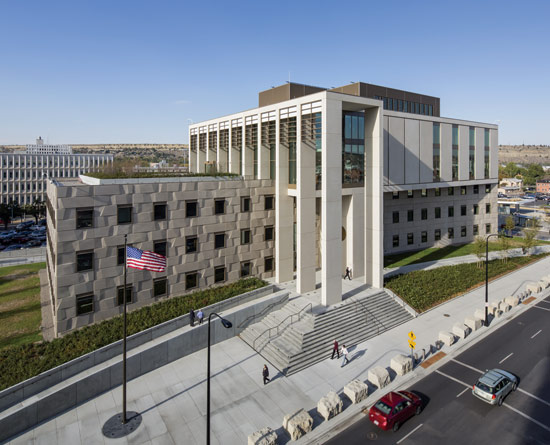Precast Concrete for High Performance Building Envelopes
Barrier wall system. Precast concrete panels are considered air and watertight. A properly designed precast wall system is a “rain barrier” that provides better performance and requires less materials and trades than conventional cavity wall systems or rain screens. Concrete in general provides a relatively good vapor retarder, assuming it remains crack free—achieved by standard specifications for compressive strength, etc.—and that penetrations, joints and interfaces with other materials are properly detailed. Three inches of high strength concrete constitutes a code-compliant vapor retarder. Air entrainment is used to improve freezing and thawing resistance, particularly in severe environments.
Functional resilience. Expressing a building's ability to withstand and be quickly restored to its full functional capacity with minimal effort and resources after natural or man-made disasters, functional resilience expands the concepts of sustainability and durability. Functional resilience also helps minimize negative effects to the environment after such an event, since resilient structures do not need to be completely rebuilt. Precast concrete has a solid track record for ensuring the attributes of resiliency, including a long service life, durability, life safety, and wind and water resistance.
 |
The James F. Battin Courthouse in Montana used a precast concrete solution to meet their high-performance requirements including anti-terrorism force protection design. Photo © Sean Airhart/NBBJ |
Multi-hazard protection. High-performance precast concrete wall panels are strong enough to withstand high winds and wind-driven projectiles, hurricanes, and wildfires. The high strengths and low water-cementitious ratios used in the precast manufacturing process, combined with proper compaction imbue the material with the capacity to withstand storms and render it resistant to wind-driven rain and moist, outdoor air in hot and humid climates. In short, concrete is impermeable to air infiltration and wind-driven rain. Architects should note, as with all envelope systems, joints between panels must be properly installed and maintained in order to provide a complete barrier system. Precast concrete walls should be allowed to breathe on at least one side and should not be covered by an impermeable material on both wall surfaces.
Research shows that appropriately designed precast concrete framing systems have a proven capacity to withstand major earthquakes, as demonstrated by recent earthquakes in Guam, United States (Richter scale 8.1); Manila, Philippines (Richter scale 7.2); and Kobe, Japan (Richter scale 6.9). These events subjected precast buildings to some of nature's deadliest forces.
Unlike seismic and wind loads, blast loads have an extremely short duration that can be measured in milliseconds. Often, the large mass associated with the overall building response provides enough inertia so the building's framing does not need to be strengthened to resist blast loads. While conventional foundation systems are almost always adequate to resist the short duration reaction loads from a building's response to blast loads, architectural precast concrete can be designed to mitigate the effects of an explosion and thereby satisfy requirements of the General Services Administration. In fact, extensive research on seismic and blast design with the Air Force Research Laboratory has generated increased use of precast concrete in seismic zones and military and government structures, which have antiterrorism force protection requirements.
• Life safety and health. A building's resilience is also dependent on systems that ensure indoor environmental quality and protection from fire and other disasters.
Indoor environmental quality. Volatile organic compounds (VOC) are environmental hazards that degrade indoor air quality when they off-gas from new products, such as manufactured wood items like laminate and particleboard. VOCs can also combine with other chemicals in the air to form ground-level ozone. Concrete contains low to negligible VOCs, far less than almost any other typical interior finish product.
Precast concrete surfaces are often used as durable interior finish. Polished concrete floors do not require carpeting. Exposed concrete walls do not require finishing materials, eliminating particulates from sanding drywall taping seams. Concrete is not damaged by moisture and does not provide nutrients for mold growth. Precast has low sound transmission classification and impact insulation class ratings, providing architects with inherent material qualities with which to meet increasingly more stringent indoor acoustical requirements.
The negligible level of VOCs in concrete construction can be further reduced by using low-VOC materials for form-release agents, curing compounds, damp-proofing materials, wall and floor coatings and primers, membranes, sealers, and water repellents. Precast concrete components also work to meet standards for indoor air quality because they are delivered to the site in modules that do not require fabrication, processing, or cutting at the construction site, thereby reducing dust and airborne contaminants on site.









